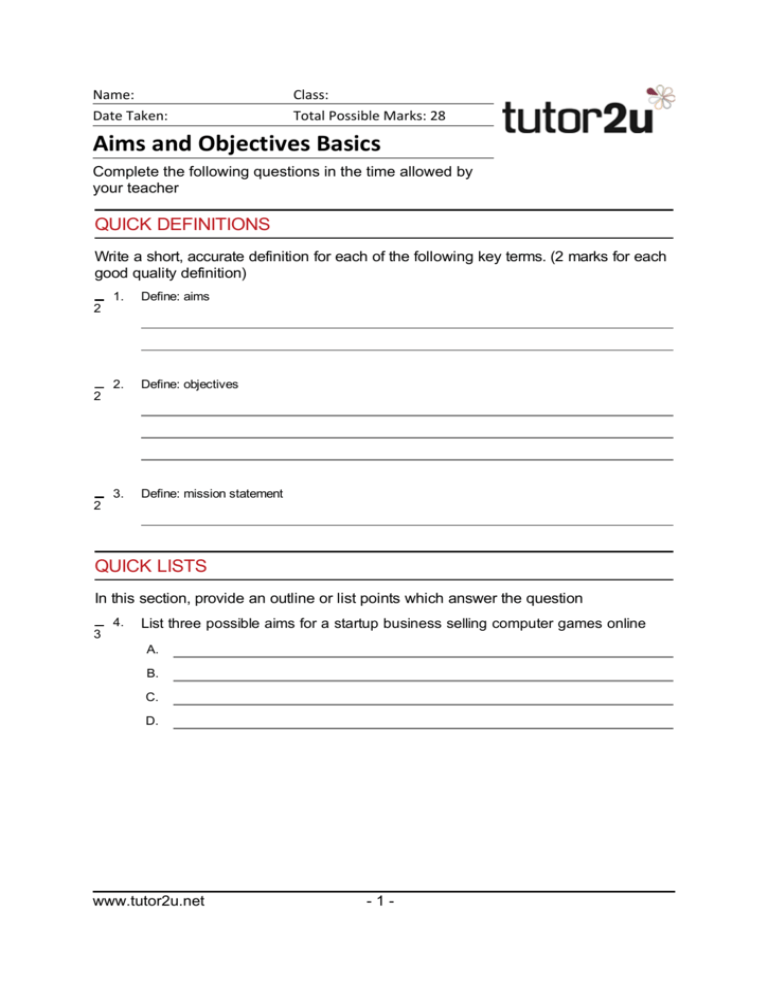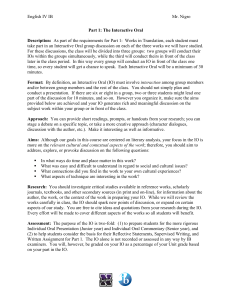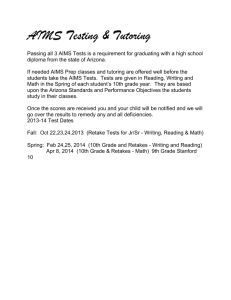Aims and Objectives Basics
advertisement

Name: Date Taken: Class: Total Possible Marks: 28 Aims and Objectives Basics Complete the following questions in the time allowed by your teacher QUICK DEFINITIONS Write a short, accurate definition for each of the following key terms. (2 marks for each good quality definition) 1. Define: aims 2. Define: objectives 3. Define: mission statement 2 2 2 QUICK LISTS In this section, provide an outline or list points which answer the question 4. 3 List three possible aims for a startup business selling computer games online A. B. C. D. www.tutor2u.net -1- -25. 3 Outline three advantages of a business setting clear objectives A. B. C. D. E. 6. 5 Good objectives are often said to comply with the acronym SMART. What does SMART stand for? A. B. C. D. E. www.tutor2u.net -2- -3- Short Answers In this section, write a short answer (one or two sentences) for each question. 7. Using an example, explain the difference between an aim and an objective 8. Briefly explain who sets the aims and objectives for a business 9. Explain why the aims of a startup business are likely to differ from those of a well-established business 3 3 5 www.tutor2u.net -3- Name: Date Taken: Class: Total Possible Marks: 28 Aims and Objectives Basics Complete the following questions in the time allowed by your teacher QUICK DEFINITIONS Write a short, accurate definition for each of the following key terms. (2 marks for each good quality definition) 1. Define: aims 2 Aims are things that a business wants to achieve E.g. to survive, to be profitable, to grow sales 2. Define: objectives 2 Objectives are statements of specific outcomes that are to be achieved Objectives differ from aims in that they provide some targets against which performance can be measured 3. Define: mission statement 2 A mission statement describes the overall purpose of a business - what the business exists to do QUICK LISTS In this section, provide an outline or list points which answer the question 4. 3 List three possible aims for a startup business selling computer games online A. Survival - continuing to trade without the business failing B. Reaching break-even C. Attracting and retaining new customers D. Providing a good quality of customer service www.tutor2u.net -1- -25. 3 6. 5 Outline three advantages of a business setting clear objectives A. Provides management and employees with a sense of direction B. Enables actual performance to be measured against targets C. Focuses the business on activities that matter D. Can help motivate employees E. Helps with the allocation of resources between business activities Good objectives are often said to comply with the acronym SMART. What does SMART stand for? A. Specific: the objective should state exactly what is to be achieved B. Measurable: an objective should be capable of measurement - so that it is possible to determine whether (or how far) it has been achieved C. Achievable: the objective should be realistic given the circumstances in which it is set and the resources available to the business D. Relevant: objectives should be relevant to the people responsible for achieving them E. Timed: objectives should be set with a time-frame in mind, which also needs to be realistic www.tutor2u.net -2- -3- Short Answers In this section, write a short answer (one or two sentences) for each question. 7. 3 Using an example, explain the difference between an aim and an objective Valid points include: An aim is a more general statement of what a business wants to achieve. E.g. the firm wants to grow its market share An objective is a specific, measurable target which the business wants to achieve in a certain time-scale. E.g. the firm wants to grow market share from 8% to 12% by 2012 8. 3 Briefly explain who sets the aims and objectives for a business In general, the business owners set the aims and objectives. In many cases (particularly small businesses) the owners are also the directors/managers of the firm 9. 5 Explain why the aims of a startup business are likely to differ from those of a well-established business Valid points include: The aims of the two kinds of business will vary because of their differing circumstances A startup business faces much more uncertainty about whether the business will be viable - will customers demand the product? Can it be delivered profitably? Can enough revenue be earned in order to reach break-even: Does the business have sufficient resources, particularly financial? As a result, the aims of a startup tend to be focused around achieving survival and establishing the products in the target market. An established business faces fewer risks of failure. Aims will very much depend on what the business owners want for the firm. They may aim to maximise profitability, or sales revenue, or both. The owners may wish to focus on maximising the cash flows from their business. Or they may aim to trade ethically or to focus on environmentally-friendly activities. www.tutor2u.net -3-








